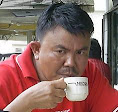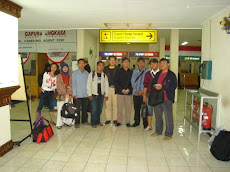Senin, 14 April 2008

By Kristianus Atok
I. Introduction
Tanah adat is the term presently popular in Indonesia to refer to lands managed by indigenous communities. The term developed earlier was use tanah ulayat. But tanah ulayat applies especially among Minang communities in West Sumatra. Active intervention of human being with the process of turning natural functions of lands to economical ones is the core of the concept.
The Dayaks in West Kalimantan have land ownership concept which has a broader meaning. The Kanayatn Dayaks (who live in most part of Pontianak Regency and a part of Sambas Regency) have a concept called palasar palaya’. Palasar palaya is a common word which is often heard in everyday conversations among Kanayatn community members. This term refers to boundaries of resource management territory of a kampung, a village-like smallest territorial system which originally has its own land-use and other resources, settlement and institutions (ampu’ sakampongan). The concept contains not only the fact that natural functions of land has been turned into economical functions by those who own or manage the lands but also the whole environment (including primary forests) of the lands or territory.
Palasar palaya’ includes the whole territory of a kampung in which all members of the community understand the land allocation. It is quite rare that a community member encroaches a land on which he or she has no rights. In this concept lands fall into several categories based on the functions. There are sacred land (local people call it karamat and in it there can be types of shrines like Panyugu, Padagi, Pantulak, Kadiaman, etc), hunting area (udas nang aya’ bakayu nang tinggi
The concept blends perfectly lands, resources and their functions for human life. In this concept, resources should be managed in commensurate with the carrying capacity of the environment.
II. Palasar Palaya and Modern Land Use
It is quite impossible that lands exist without space. Lands without space is like sand in a sack. It is formless and has no fix position and it can be moved anywhere. Palasar palaya’ is the land and the space in one wholeness. Its boundaries are the (oral) agreement(s) among two or more groups in earlier times. Controls are exercised by both human being and nature. Nature will apply sanctions against human being who breaks the rules. And this sometimes applies mysteriously.
What about the concept of modern land-use? In July to October 1997 haze blanketed the atmosphere of Kalimantan and other parts of Indonesia. The haze came out of the forests on fire which was aggravated by El-Nino phenomenon (the heating of sea in the Pacific because of holes in the ozon layer above which causes dry air effect). People burnt down logs and bushes when they cleared land for plantations. The fire was out of control and set the forests on fire. But why they did the burning? This is because modern people neglect natural norms in arranging spatial allocations. Converting lands to another function in large scale (thousands of hectares) is an example of practices that neglect natural norms.
Modern land-use is determined by economical functions of space. This is the opposite of traditional land use (palasar palaya). Modern land-use is macro (general) while traditional land-use is micro (specific). To compare the two see the following
Table 1
Modern and Traditional Land-Use
No Modern Land-Use Traditional Land-Use
01 Protection Forest Tanah Karamat
Panyugu
Padagi
Ulu Ai,
Bukit Nang Tingi
Batu nang Aya,
Patunuan
Kadiaman
Kayu nang Aya’
Panamukng/Panyantu’atn
02 Wet Cultivation Papuk/bancah
Tawakng
Gente
Tamunan
03 Dry Cultivation Mototn
Tabuk
Tanyukng
Kabon gatah
Kompokng Buah
04 Limited Production Forest Pararoatn/Parokng
Udas pangesekatn
III. Palasar Palaya and the Contents
When boundaries of palasar palaya’ is first set, the consideration is based on:
a. natural riches in it,
b. the history of migration of the community who manages it
a. natural riches
For the early generation natural riches were materials which were extracted from nature that could be use to sustain their existence without prior process. These were sago, types of tubers, etc (as carbohydrate sources), catches, games (as protein sources), fruits (as vitamin and mineral sources) and certain tree trunks and tree bark for construction and material for clothing. In the development the they added up the types of the things they utilized and increased the variations and diversification of the sources. (See table 2 and 3)
b. history of migration
As an illustration let’s follow the migration of early generation of population of Kampung Nangka in the sub-district of Menjalin, in the rRegency of Pontianak, West Kalimantan, as follows: The first generation of Nankga populaton came from Timawakng Babah Are. The were: Bocong, Sampe, Gati, Longken, Nyantom, Manto and Tuah. From Timawakng Babah Are they moved to Tumiang then moved to Kamuri’ and at last to Nangka. (Timawakng Nangka is at located behind the house of Yeri’s father’s house in Kampung Nangka).
When they settled in Nangka they set up parokngs in Piangu, Tangket, Kubita, Latokng, Jungkung and Tima. Long after Parokng Jungkung developed into a quite big settlement. Those who settled in Jungkung set up parokngs in Pak Mundi, Lago’. The sketch of their migration is as follows.
Babah Are
Tumiang Raba
Kamuri Konyo Duling
Piangu
Nangka Pak Mundi
Latokng
Tangket Jungkukng
Tima’
Kubita
Genealogy tracing estimate that Timawakng Babah Are dates back to 1250 AD.
What would you say of the sketch? The sketch depicts the territory of Palasar Palaya of Kampung Nangka at present. If we measured all of it with mapping equipment we would produce a map of palasar palaya’.
IV. Palasar Palaya’ and Participatory Mapping
Palasar Palaya’ has been set up to prosper its inhabitants. On the one hand the inhabitants increase in number from time to time while on the other the palasar palaya’ does not expand. Therefore a measurement is needed to make further planning. One of the way to measure is to map it participatorily.
Participatory mapping is an activity of making maps which involves all members of a community in the area to be mapped. All people involved in the activity play equal roles and do things equally. The objective is that the maps produced meet a standard required by mapping technology. The maps are also effective and optimal. It is effective in the sense that the maps are readable and understandable by both the people who are accustomed to using maps and by less educated community members. It is optimal in the sense that the maps are utilized dynamically.
V. Palasar Palaya’ and the Present Situation of the Communities
Most of the community members within the palasar palaya’ are generally poor and powerless. Meanwhile they possess lands with resources. What is actually happening? The following story can serve as an illustration.
In a rural program planning meeting a government officer would say to the people,’ In this occasion I will ask you all to implement drinking water project. The program has been planned long before to help you cope with the drinking water problem. As we know water is scarce in this area both in wet and dry seasons. Do you agree with the program?
The above story indicates that the program does not belong to the people. The planning is top-down. In such planning the people tend to be treated as object.
The participatory mapping offers these steps: first the local people map their resources in the palasar palaya’. Then analysis is done and then the local people are facilitated to make planning over their palasar palaya’. To optimize the result the facilitators can involve third parties (funding agencies or the government). This is a bottom-up planning.
VI. Conclusion
The existence of the Dayaks is undoubtedly indicated by their resource management system in the concept of palasar palaya’. Along the history the Dayaks live the concept.
Will this system endure? The answer depends on the present Dayak generation. Their understanding of the concept and supporting bodies or individuals play quite important role.











1 Comment:
Hi Kris, very good piece on the concept of land management which works with a different dimension applied in spatial planning.
Cheers Johan
Post a Comment